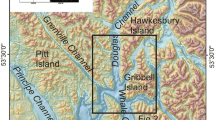Abstract
Based on high-resolution bathymetric records, sub-bottom profiles and sediment cores, we study postglacial mass transport deposits, slide scar complexes, cyclic steps and rockfall deposits as indicators of mass failures in the inner Hardangerfjorden system, western Norway. The stacked mass transport deposits show thicknesses of up to 4 m and witness that the inner Hardangerfjorden has been a site of repetitive mass failure events, potentially triggered by earthquakes related to glacioisostatic uplift. The cyclic steps, affecting an area of about 2 km2 in the innermost fjord, have wave lengths of 40 m, heights of 5 m and are most likely related to fluvial sediment supply. Seven slide scar complexes, with stratigraphy-cutting scar heights of 6–34 m, are identified on the basin plain of the fjord. These are all associated with large depocenters along the fjord flanks, suggesting a link between locations of high sediment supply and mass failure. Although rapid deposition might, by itself, induce failures, an external trigger mechanism, such as an earthquake, should also be considered.
Access this chapter
Tax calculation will be finalised at checkout
Purchases are for personal use only
Similar content being viewed by others
References
Aarseth I, Løhne Ø, Giskeødegaard O (1989) Submarine slides in glaciomarine sediments in some western Norwegian fjords. Mar Geol 88:1–21
Ahjos T, Uski M (1992) Earthquakes in northern Europe in 1375–1989. Tectonophysics 207:1–23
Anundsen K, Simonsen A (1967) Et pre-borealt breframstøt på Hardangervidda og i området mellom Bergensbanen og Jotunheimen. Årbok for Universitetet i Bergen. Matematisk-naturvitenskapelige serie 7, 1–42
Bøe R, Longva O, Lepland A, Blikra LH, Sønstegaard E, Haflidason H, Bryn P, Lien R (2004) Postglacial mass movements and their causes in fjords and lakes in western Norway. Nor J Geol 84:35–55
Bungum H, Lindholm C, Faleide JI (2005) Postglacial seismicity offshore mid-Norway with emphasis on spatio-temporal-magnitudal variations. Mar Pet Geol 22:137–148
Hicks EC, Ottemöller LR (2001) The ML 4.5 Stord/Bømlo, southwestern Norway, earthquake of 12 August 2000. Nor J Geol 81:293–304
Hjelstuen BO, Kjennbakken H, Bleikli V, Ersland RA, Kvilhaug S, Euler C, Alvheim S (2013) Fjord stratigraphy and processes – evidence from the NE Atlantic Fensfjorden system. J Quat Sci 28:421–432
Holtedahl H (1975) The geology of the Hardangerfjord, West Norway. Norges Geol Unders 323:1–87
Holtedahl O, Dons JA (1960) Geological map of Norway. Norges Geol Unders 208
Hughes Clarke JE, Vidiera Marques CR, Pratomo D et al (2014) Imaging active mass-wasting and sediment flows on a Fjord delta, Squamish, British Columbia. In: Krastel S (ed) Submarine mass movements and their consequences, Advances in natural and technological hazards research. Springer, Dordrecht, pp 249–260
Kvalstad TJ, Andresen L, Forsberg CF, Berg K, Bryn P, Wangen M (2005) The Storegga slide: evaluation of triggering sources and slide mechanics. Mar Pet Geol 22:245–256
L’Heureux JS, Hansen L, Longva O, Emdal A, Grande LO (2010) A multidisciplinary study of submarine landslides at the Nidelva fjord delta, Central Norway – implications for geohazard assessment. Nor J Geol 90:1–20
Lee SH, Chough SK (2001) High-resolution (2–7 kHz) acoustic and geometric characters of submarine creep deposits in the South Korea Plateau, East Sea. Sedimentology 48:629–644
Locat J, Leroueil S, Locat A, Lee H (2014) Weak layers: their definition and classification from a geotechnical perspective. In: Krastel S et al (eds) Submarine mass movements and their consequences, Advances in natural and technological hazards research. Springer, Dordrecht, pp 3–12
Longva O, Janbu N, Blikra LH, Bøe R (2003) The 1996 Finneidfjord slide; seafloor failure and slide dynamics. In: Locat J, Mienert J (eds) Submarine mass movements and their consequences, Advances in natural and technological hazards research. Kluwer Academic, Dordrecht, pp 531–538. ISBN 19
Mangerud J, Gyllencreutz R, Lohne ØS, Svendsen JI (2011) Glacial history of Norway. In: Ehlers J et al (eds) Quaternary glaciations – extent and chronology. Elsevier, Amsterdam
Mangerud J, Goehring BM, Lohne ØS, Svendsen JI, Gyllencreutz R (2013) Collapse of marine-based outlet glaciers from the Scandinavian ice sheet. Quat Sci Rev 67:8–16
St-Onge G, Chapron E, Mulsow S, Salas M, Viel M, Debret M, Foucher A, Mulder T, Winiarski T, Desmet M, Costa PJM, Ghaleb B, Jaouen A, Locat J (2012) Comparison of earthquake-triggered turbidites from the Saguenay (Eastern Canada) and Reloncavi (Chilean margin) Fjords: implications for paleoseismicity and sedimentology. Sediment Geol 243–244:89–107
www.geonorge.no, Kartverket, The Norwegian map** authority, Hønefoss, Norway, 25.11.2014
www.norgeibilder.no, Kartverket, The Norwegian map** authority, Hønefoss, Norway, 25.11.2014
www.nve.no, Norges vassdrags- og energidirektorat (NVE), Norwegian water resources and energy directorate, Oslo, Norway, 10.12.2014
Acknowledgements
We acknowledge Statnett and DOF Subsea Norway AS for access to high-resolution bathymetric data and thank Oddvar Longva and Jasper Moernaut for revision of the paper. The research leading to these results has received funding from the People Programme (Marie Curie Actions) of the European Union’s Seventh Framework Programme FP7/2007–2013/ under REA grant agreement n° 317217. The research forms part of the GLANAM (GLAciated North Atlantic Margins) Initial Training Network.
Author information
Authors and Affiliations
Corresponding author
Editor information
Editors and Affiliations
Rights and permissions
Copyright information
© 2016 Springer International Publishing Switzerland
About this chapter
Cite this chapter
Bellwald, B., Hjelstuen, B.O., Sejrup, H.P., Haflidason, H. (2016). Postglacial Mass Failures in the Inner Hardangerfjorden System, Western Norway. In: Lamarche, G., et al. Submarine Mass Movements and their Consequences. Advances in Natural and Technological Hazards Research, vol 41. Springer, Cham. https://doi.org/10.1007/978-3-319-20979-1_7
Download citation
DOI: https://doi.org/10.1007/978-3-319-20979-1_7
Publisher Name: Springer, Cham
Print ISBN: 978-3-319-20978-4
Online ISBN: 978-3-319-20979-1
eBook Packages: Earth and Environmental ScienceEarth and Environmental Science (R0)




